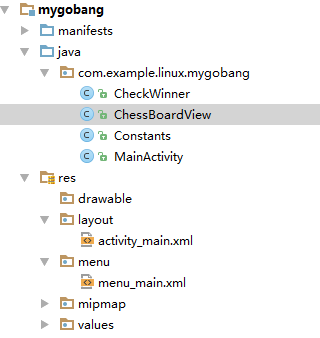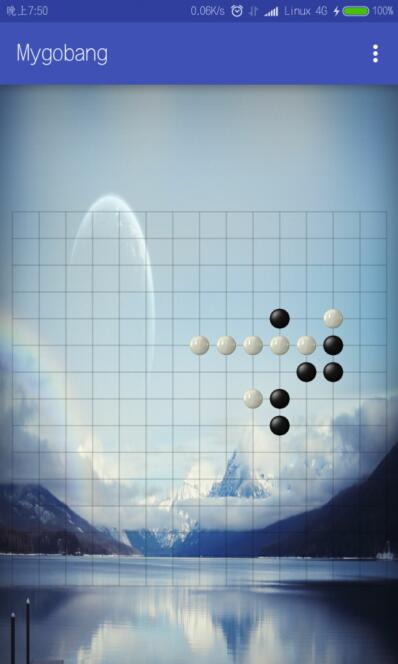
- Android获取apk程序签名信息代码示例
- Android App开发中将View或Drawable转为Bitmap的方法
- Android 按指定大小读取图片的实例
- Android中实现基本的短信拦截功能的代码示例
- Android编程使用Intent传递对象的方法分析
- android在异步任务中关闭Cursor的代码方法
- android 图片操作(缩放移动) 实例代码
- Android视图控件架构分析之View、ViewGroup
- [Android开发视频教程]03_03_用户定位(一)
- android dialog边框去除白色边框实现思路及代码
- Android手机抓包步骤
- android模拟器开发和测试nfc应用实例详解
- Android入门之TableLayout应用解析(二)
- 使用AndroidStudio上传忽略文件至SVN Server的解决办法
- 20行Android代码写一个CircleImageView
- Android判断用户的网络类型实例讲解(2/3/4G、wifi)
- Android 听筒模式的具体实现实例
- Android编程使用ListView实现数据列表显示的方法
- Android实现Activity、Service与Broadcaster三大组件之间互相调用的方法详解
- android实现横屏的代码及思路
- Android仿微信朋友圈实现滚动条下拉反弹效果
- 通过Android trace文件分析死锁ANR实例过程
- 安卓应用开发通过java调用c++ jni的图文使用方法
- Android中的Intent对象完全解析
- Android解析Intent Filter的方法
- Android实现可使用自定义透明Dialog样式的Activity完整实例
- android notification 的总结分析
- Android App开发中创建Fragment组件的教程
- Android实现自动填写获取验证码功能
- [Android开发视频教程]02_10_Animations的使用(三)
Android五子棋游戏程序完整实例分析
作者:佚名 Android开发编辑:admin 更新时间:2022-07-23
最近学习了五子棋的课程,感觉挺不错。然后自己写了个关于五子棋的android程序,从中还是能够学习到很多东西的。现在我们开始今天五子棋程序的编写历程。程序的源码请参见友情链接:
好了,我们现在开始一步步的构建出项目来,首先是如下的项目结构图:

运行的效果图:

一些前期做准备的代码
1、 主活动类MainActivity,在菜单中加入了再来一局的功能:
public class MainActivity extends AppCompatActivity {
private ChessBoardView chessBoardView;
@Override
protected void onCreate(Bundle savedInstanceState) {
super.onCreate(savedInstanceState);
setContentView(R.layout.activity_main);
chessBoardView = (ChessBoardView) findViewById(R.id.boardView);
}
@Override
public boolean onOptionsItemSelected(MenuItem item) {
int id = item.getItemId();
// 再来一局
if (id == R.id.action_setting) {
chessBoardView.start();
return true;
}
return super.onOptionsItemSelected(item);
}
@Override
public boolean onCreateOptionsMenu(Menu menu) {
getMenuInflater().inflate(R.menu.menu_main, menu);
return true;
}
}
2、常量类便于维护管理:Constants
public class Constants {
// 五子连珠
public final static int MAX_COUNT_IN_LINE = 5;
// 棋盘的行数
final static int MAX_LINE = 15;
// 检查的方向
final static int HORIZONTAL = 0;
final static int VERTICAL = 1;
final static int LEFT_DIAGONAL = 2;
final static int RIGHT_DIAGONAL = 4;
}
3、activity_main.xml中增加了自定义棋盘的View:
<?xml version="1.0" encoding="utf-8"?> <RelativeLayout xmlns:android="http://schemas.android.com/apk/res/android" xmlns:tools="http://schemas.android.com/tools" android:layout_width="match_parent" android:layout_height="match_parent" android:background="@mipmap/bg" tools:context="com.example.linux.mygobang.MainActivity"> <com.example.linux.mygobang.ChessBoardView android:id="@+id/boardView" android:layout_centerInParent="true" android:layout_width="match_parent" android:layout_height="match_parent" /> </RelativeLayout>
4、menu_main.xml中定义再来一局的菜单:
<?xml version="1.0" encoding="utf-8"?> <menu xmlns:tools="http://schemas.android.com/tools" xmlns:android="http://schemas.android.com/apk/res/android"> <item android:id="@+id/action_setting" android:title="再来一局" android:orderInCategory="100" android:showAsAction="never" tools:ignore="AppCompatResource" /> </menu>
自定义棋盘的View
ChessBoardView类,是整个程序比较核心的部分。
1、初始化工作,程序中用到的变量也放在下面的代码中:
// 棋盘的宽度,也是长度
private int mViewWidth;
// 棋盘每格的长度
private float maxLineHeight;
private Paint paint = new Paint();
// 定义黑白棋子的Bitmap
private Bitmap mwhitePiece, mblackPiece;
private float ratioPieceOfLineHeight = 3 * 1.0f / 4;
// 判断当前落下的棋子是否是白色的
private boolean mIsWhite = true;
// 记录黑白棋子位置的列表
private ArrayList<Point> mwhiteArray = new ArrayList<>();
private ArrayList<Point> mblackArray = new ArrayList<>();
// 游戏是否结束
private boolean mIsGameOver;
// 游戏结束,是否是白色方胜利
private boolean mIsWhiteWinner;
public ChessBoardView(Context context, AttributeSet attrs) {
super(context, attrs);
init();
}
private void init() {
paint.setColor(0x88000000);
paint.setAntiAlias(true);
paint.setDither(true);
paint.setStyle(Paint.Style.STROKE);
mwhitePiece = BitmapFactory.decodeResource(getResources(), R.mipmap.stone_w2);
mblackPiece = BitmapFactory.decodeResource(getResources(), R.mipmap.stone_b1);
}
2、onMeasure方法,测量View的大小,使View的长宽一致。
@Override
protected void onMeasure(int widthMeasureSpec, int heightMeasureSpec) {
int widthSize = MeasureSpec.getSize(widthMeasureSpec);
int widthModel = MeasureSpec.getMode(widthMeasureSpec);
int heightSize = MeasureSpec.getSize(heightMeasureSpec);
int heightModel = MeasureSpec.getMode(heightMeasureSpec);
int width = Math.min(widthSize, heightSize);
if (widthModel == MeasureSpec.UNSPECIFIED) {
width = heightSize;
} else if (heightModel == MeasureSpec.UNSPECIFIED) {
width = widthSize;
}
setMeasuredDimension(width, width);
}
2、onSizeChanged方法在布局的阶段,如果View的大小发生改变,此方法得到调用。
@Override
protected void onSizeChanged(int w, int h, int oldw, int oldh) {
super.onSizeChanged(w, h, oldw, oldh);
mViewWidth = w;
maxLineHeight = mViewWidth * 1.0f / Constants.MAX_LINE;
int pieceWidth = (int) (maxLineHeight * ratioPieceOfLineHeight);
mwhitePiece = Bitmap.createScaledBitmap(mwhitePiece, pieceWidth, pieceWidth, false);
mblackPiece = Bitmap.createScaledBitmap(mblackPiece, pieceWidth, pieceWidth, false);
}
4、onTouchEvent方法中处理我们下棋子的位置:
@Override
public boolean onTouchEvent(MotionEvent event) {
if (mIsGameOver) {
return false;
}
int action = event.getAction();
if (action == MotionEvent.ACTION_UP) {
int x = (int) event.getX();
int y = (int) event.getY();
Point point = getValidPoint(x, y);
if (mwhiteArray.contains(point) || mblackArray.contains(point)) {
return false;
}
if (mIsWhite) {
mwhiteArray.add(point);
} else {
mblackArray.add(point);
}
invalidate();
mIsWhite = !mIsWhite;
}
return true;
}
5、在onDraw方法做棋盘的绘制工作:
@Override
protected void onDraw(Canvas canvas) {
super.onDraw(canvas);
// 绘制棋盘的网格
drawBoard(canvas);
// 绘制棋盘的黑白棋子
drawPieces(canvas);
// 检查游戏是否结束
checkGameOver();
}
6、接下来,我们按上面的流程,一个个的做详细的解释:
绘制棋盘的网格:
// 绘制棋盘的网线
private void drawBoard(Canvas canvas) {
int w = mViewWidth;
float lineHeight = maxLineHeight;
for (int i = 0; i < Constants.MAX_LINE; i++) {
int startX = (int) (lineHeight / 2);
int endX = (int) (w - lineHeight / 2);
int y = (int) ((0.5 + i) * lineHeight);
canvas.drawLine(startX, y, endX, y, paint);
canvas.drawLine(y, startX, y, endX, paint);
}
}
绘制棋盘的黑白棋子:
// 根据黑白棋子的数组绘制棋子
private void drawPieces(Canvas canvas) {
for (int i = 0, n = mwhiteArray.size(); i < n; i++) {
Point whitePoint = mwhiteArray.get(i);
float left = (whitePoint.x + (1 - ratioPieceOfLineHeight) / 2) * maxLineHeight;
float top = (whitePoint.y + (1 - ratioPieceOfLineHeight) / 2) * maxLineHeight;
canvas.drawBitmap(mwhitePiece, left, top, null);
}
for (int i = 0, n = mblackArray.size(); i < n; i++) {
Point blackPoint = mblackArray.get(i);
float left = (blackPoint.x + (1 - ratioPieceOfLineHeight) / 2) * maxLineHeight;
float top = (blackPoint.y + (1 - ratioPieceOfLineHeight) / 2) * maxLineHeight;
canvas.drawBitmap(mblackPiece, left, top, null);
}
}
检查游戏是否已经结束:
// 检查游戏是否结束
private void checkGameOver() {
CheckWinner checkWinner = new CheckWinner();
boolean whiteWin = checkWinner.checkFiveInLineWinner(mwhiteArray);
boolean blackWin = checkWinner.checkFiveInLineWinner(mblackArray);
if (whiteWin || blackWin) {
mIsGameOver = true;
mIsWhiteWinner = whiteWin;
String text = mIsWhiteWinner ? "白棋胜利" : "黑棋胜利";
Toast.makeText(getContext(), text, Toast.LENGTH_SHORT).show();
}
}
保存残局并恢复棋局
1、 保存残局,例如切换横坚屏时:
private static final String INSTANCE = "instance";
private static final String INSTANCE_GAME_OVER = "instance_game_over";
private static final String INSTANCE_WHITE_ARRAY = "instance_white_array";
private static final String INSTANCE_BLACK_ARRAY = "instance_black_array";
@Override
protected Parcelable onSaveInstanceState() {
Bundle bundle = new Bundle();
bundle.putParcelable(INSTANCE, super.onSaveInstanceState());
bundle.putBoolean(INSTANCE_GAME_OVER, mIsGameOver);
bundle.putParcelableArrayList(INSTANCE_BLACK_ARRAY, mblackArray);
bundle.putParcelableArrayList(INSTANCE_WHITE_ARRAY, mwhiteArray);
return bundle;
}
2、 从bundle中恢复棋局:
@Override
protected void onRestoreInstanceState(Parcelable state) {
if (state instanceof Bundle) {
Bundle bundle = (Bundle) state;
mIsGameOver = bundle.getBoolean(INSTANCE_GAME_OVER);
mwhiteArray = bundle.getParcelableArrayList(INSTANCE_WHITE_ARRAY);
mblackArray = bundle.getParcelableArrayList(INSTANCE_BLACK_ARRAY);
super.onRestoreInstanceState(bundle.getParcelable(INSTANCE));
return;
}
super.onRestoreInstanceState(state);
}
3、 增加再来一局游戏的逻辑:
// 再来一局
public void start() {
mwhiteArray.clear();
mblackArray.clear();
mIsGameOver = false;
mIsWhiteWinner = false;
invalidate();
}
判断游戏是否结束的算法
在CheckWinner中,对棋盘中的棋子做”米“字型的检查是否五子连珠:
1、 check方法中,针对不同的方向,做判断:
private boolean check(int x, int y, List<Point> points, int checkOri) {
int count = 1;
for (int i = 1; i < Constants.MAX_COUNT_IN_LINE; i++) {
switch (checkOri) {
case Constants.HORIZONTAL:
point1 = new Point(x - i, y);
break;
case Constants.VERTICAL:
point1 = new Point(x, y - i);
break;
case Constants.LEFT_DIAGONAL:
point1 = new Point(x - i, y + i);
break;
case Constants.RIGHT_DIAGONAL:
point1 = new Point(x + i, y + i);
break;
}
if (points.contains(point1)) {
count++;
} else {
break;
}
}
for (int i = 1; i < Constants.MAX_COUNT_IN_LINE; i++) {
switch (checkOri) {
case Constants.HORIZONTAL:
point2 = new Point(x + i, y);
break;
case Constants.VERTICAL:
point2 = new Point(x, y + i);
break;
case Constants.LEFT_DIAGONAL:
point2 = new Point(x + i, y - i);
break;
case Constants.RIGHT_DIAGONAL:
point2 = new Point(x - i, y - i);
break;
}
if (points.contains(point2)) {
count++;
} else {
break;
}
}
if (count == Constants.MAX_COUNT_IN_LINE) {
return true;
}
return false;
}
2、 做四个方向检查:
// 横向判断
private boolean checkHorizontal(int x, int y, List<Point> points) {
checkModel = Constants.HORIZONTAL;
return check(x, y, points, checkModel);
}
// 竖向判断
private boolean checkVertical(int x, int y, List<Point> points) {
checkModel = Constants.VERTICAL;
return check(x, y, points, checkModel);
}
// 左斜判断
private boolean checkLeftDiagonal(int x, int y, List<Point> points) {
checkModel = Constants.LEFT_DIAGONAL;
return check(x, y, points, checkModel);
}
// 右斜判断
private boolean checkRighttDiagonal(int x, int y, List<Point> points) {
checkModel = Constants.RIGHT_DIAGONAL;
return check(x, y, points, checkModel);
}
3、 做具体的判断,是否游戏结束:
private Point point1, point2;
private int checkModel = -1;
public boolean checkFiveInLineWinner(List<Point> points) {
for (Point point : points) {
int x = point.x;
int y = point.y;
if (checkHorizontal(x, y, points)) {
return true;
} else if (checkVertical(x, y, points)) {
return true;
} else if (checkLeftDiagonal(x, y, points)) {
return true;
} else if (checkRighttDiagonal(x, y, points)) {
return true;
}
}
return false;
}
源码下载:Android五子棋游戏程序
以上就是本文的全部内容,希望对大家学习Android软件编程有所帮助。
- 上一篇文章: 实例讲解Android中ContentProvider组件的使用方法
- 下一篇文章: Android实现View滑动的几种方式
- 详解Android中的Context抽象类
- 谈谈Android中的Divider是个什么东东
- 非常简单的Android打开和保存对话框功能
- Android 解决嵌套Fragment无法接收onCreate
- Android编程使用缓存优化ListView的方法
- Android获取设备隐私 忽略6.0权限管理
- Android程序开发之ListView实现横向滚动(带